 History
History  History
History  Weird Stuff
Weird Stuff 10 Everyday Products Surprisingly Made by Inmates
 Movies and TV
Movies and TV 10 Actors Dragged out of Retirement for One Key Role
 Creepy
Creepy 10 Lesser-Known Shapeshifter Legends from Around the World
 Animals
Animals 10 Amazing Animal Tales from the Ancient World
 Gaming
Gaming 10 Game Characters Everyone Hated Playing
 Books
Books 10 Famous Writers Who Were Hypocritical
 Humans
Humans 10 of the World’s Toughest Puzzles Solved in Record Time
 Mysteries
Mysteries 10 Scientific Mysteries We Don’t Fully Understand
 Weird Stuff
Weird Stuff 10 Celebrities Who Have Admitted to Alien Encounters
 History
History Ten Revealing Facts about Daily Domestic Life in the Old West
 Weird Stuff
Weird Stuff 10 Everyday Products Surprisingly Made by Inmates
 Movies and TV
Movies and TV 10 Actors Dragged out of Retirement for One Key Role
Who's Behind Listverse?

Jamie Frater
Head Editor
Jamie founded Listverse due to an insatiable desire to share fascinating, obscure, and bizarre facts. He has been a guest speaker on numerous national radio and television stations and is a five time published author.
More About Us Creepy
Creepy 10 Lesser-Known Shapeshifter Legends from Around the World
 Animals
Animals 10 Amazing Animal Tales from the Ancient World
 Gaming
Gaming 10 Game Characters Everyone Hated Playing
 Books
Books 10 Famous Writers Who Were Hypocritical
 Humans
Humans 10 of the World’s Toughest Puzzles Solved in Record Time
 Mysteries
Mysteries 10 Scientific Mysteries We Don’t Fully Understand
 Weird Stuff
Weird Stuff 10 Celebrities Who Have Admitted to Alien Encounters
10 Absolutely Mind-Bending Facts About Our Earth
As the Earth rotates on its axis and orbits the Sun, the Sun orbits the center of the Milky Way at a rate of 800,000 kilometers (500,000 mi) per hour. It’s dizzying how remarkable the universe has remained since its inception. Earth is a tiny piece of a much larger puzzle, and yet, its composition and inner workings are still extraordinary.
10A Volcanic Mountain Range Stretches Around The World

The mid-ocean ridge system is an immense underwater range of volcanoes. It exists due to volcanic eruptions of basaltic lava that occur between the Earth’s tectonic plates. These eruptions help produce Earth’s youngest crust in the lithosphere. At 60,000 kilometers (37,000 mi) long, the mid-ocean ridge is the largest geological feature on Earth. It winds around the globe like a baseball seam. Compare this to the Andes mountains of South America’s western border—the longest above-water range on Earth, which spans 7,200 kilometers (4,500 mi).
The mid-ocean ridge has plenty of space for Earth-changing activity. For example, when freezing ocean water seeps into the cracks of its volcanic crests, that water heats to more than 400 degrees Celsius (750 °F) and shoots up in bursts, gray-to-black in color due to the basalt minerals. These hydrothermal vents are nicknamed “black smokers.” Most of the planet’s volcanic activity occurs along the mid-ocean ridge. Its unique features vary far beyond superheated vents, but we don’t have a complete picture of what’s down there. The colossal underwater range was only discovered in the 1950s. It remains largely unexplored.
9Fire Thrives In Icy Conditions
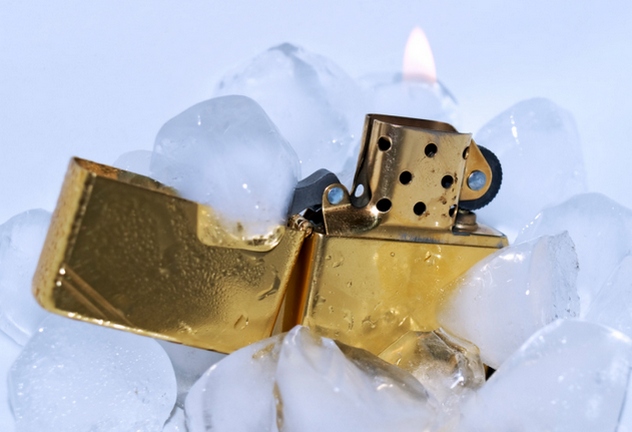
In Antarctica, extreme winds and dryness cause fire to spread swiftly. The responsibility to follow safety precautions falls on everyone’s shoulders. A fire can mean rapid loss of vital supplies and shelter. It’s near impossible to put out a large fire in Antarctica because water will simply freeze in the hose. Stations are so remote that help may be a long way off at any given time. It’s best to concentrate on prevention.
Fire safety is stressed all over the world, but people on the white continent also have a more unusual concern to address: static electricity. Low humidity and extreme winds increase the effects of static electricity enough to charge a building. Residents quickly get used to touching metal objects to ground themselves and avoid shock. A single static spark can ignite fuel vapors and start a fire. Uncontrolled static electricity may also destroy electronics such as MP3 players and cameras. Discharge plates have to be set near phones and keyboards for safety reasons. As if the concerns of fire and unexpected shock weren’t enough, there’s also Mount Erebus, an under-ice active volcano. It holds a humongous lake of sizzling-hot lava and could erupt at any time.
8Earthquakes Are No Rarity

If we take the entire world into account, earthquakes occur an estimated 500,000 times per year. About a fifth of these quakes can be felt by humans. Microearthquakes and minor earthquakes, which are both too minute to be sensed by people, occur at a rate of approximately 8,000 per day. The quakes that can be felt—but cause little to no damage—occur around 55,000 times annually. You might not realize what’s happening right under your feet.
Moderate to great earthquakes (5.0–8.9 on the Richter scale) do cause damage. They occur nearly 1,000 times per year. The stronger earthquakes occur less frequently, of course, but the injury and fatality rate for those is much higher. Extreme earthquakes are the rarest kind documented. They occur once every 20 years or so, registering 9.0–9.9 on the Richter scale. A 1556 quake of this magnitude in China killed more than 800,000, most of them cave dwellers.
There’s never been an earthquake documented at above 10.0 on the Richter scale. A “mega-quake” of such proportion is highly unlikely. Longer faults create more powerful quakes, and no identified faults are long enough to cause a disaster of that scale. Smaller quakes, though, are shaking up the Earth all the time.
7The Earth’s Core Is As Hot As The Sun
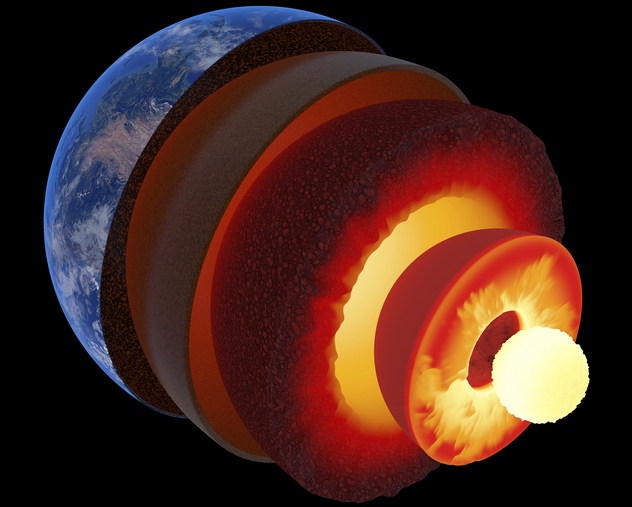
Earth is divided into three layers. The burning-hot core is molten on the outside and dense at the center. The mantle is the next layer; it’s mostly solid rock, accounting for about 84 percent of Earth’s volume. The super-thin crust is the uppermost layer that supports life. The core is the most out of reach and difficult to study. We’ve determined that the Earth’s outer core, at 2,300 kilometers (1,430 mi) thick and more than 3,900 degrees Celsius (7,000 °F), contains mostly iron and nickel. It moves with the viscosity of water.
Earth’s inner core is a ball of mostly iron alloy 1,207 kilometers (750 mi) thick. This metal orb provides the world’s protective magnetic field. It’s 6,100 degrees Celsius (11,000 °F), making it as hot as the Sun. Weight pressing down on the core keeps it solid despite the heat. We can’t drill far into the ridiculously hot portions of our inner Earth, so we rely on seismology for information. This means what we “know” is speculative and could easily change as we learn more about the planet.
6Sufficient Weight Can Warp The Land
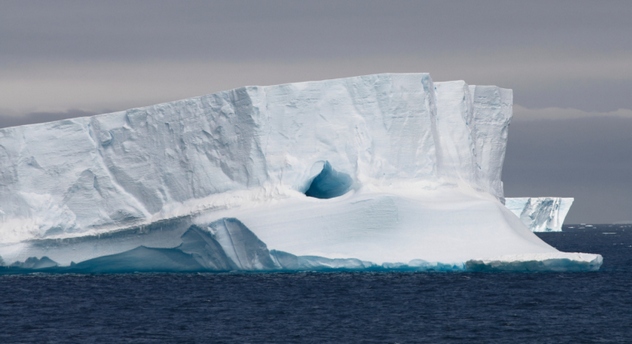
In 2002, over the course of about one month, Antarctica’s Larsen B ice shelf collapsed into the Weddell Sea. Its original surface area was about 3,250 square kilometers (1,250 mi2). This monstrous ice shelf was 220 meters (720 ft) thick and weighed a whopping 720 billion tons. That’s a lot of weight to disappear so suddenly.
To the shock of scientists, when it happened, the land that had formerly been under the ice rose. The shift was significant enough to cause changes to underground rock and lava flows, raising new concerns about the stability of local volcanoes. If all the ice covering Antarctica were to melt, the land would rise in the same way. Ocean levels would also rise by roughly 60 meters (200 ft). Most of Antarctica’s terrain is depressed by the weight of its thick ice sheets. Because they’re so heavy, a great portion of the continent’s land is currently resting below sea level.
5About 95 Percent Of The Ocean Is Still A Mystery
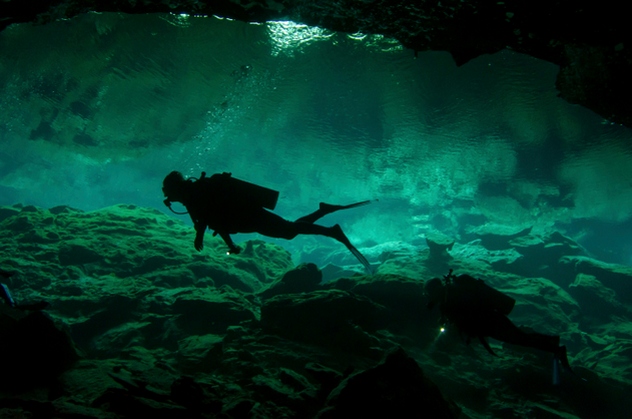
Even though water covers 71 percent of the Earth’s surface, we’ve explored only 5 percent of it. Sunlight doesn’t penetrate past approximately 275 meters (900 ft). Most ocean water darkens at a shallower depth of 30 meters (100 ft). There’s so much of the dark abyss we have yet to discover.
Millions of undiscovered species exist underwater, but many may go extinct before we have the opportunity to find and understand them. Ocean acidity has risen by 30 percent since the onset of the Industrial Revolution. That acidity destroys coral reefs and other ocean life. To make matters worse, humans frequently overfish to the point of wiping out major species. Bottom trawling essentially bulldozes the ocean floor, but that doesn’t stop humans from doing it. We also dump an estimated 180 million tons of toxic waste into the Earth’s water each year. This is unfortunate, since the ocean may hold keys to understanding complex ecosystems, cures for diseases, and so much more beyond sunken treasure.
Deep ocean pressure is powerful enough to make your body cave in many times over. Despite this unbelievable force, creatures thrive in the bottomless unknown. The Mariana Trench near Guam is the deepest part of the ocean. Even at its 10,900-meter (35,800 ft) depth, sea creatures such as a shrimp and a sea cucumber have been documented living on the floor. Just imagine the discoveries yet to come.
4The Rate Of Gravity Is Not Constant
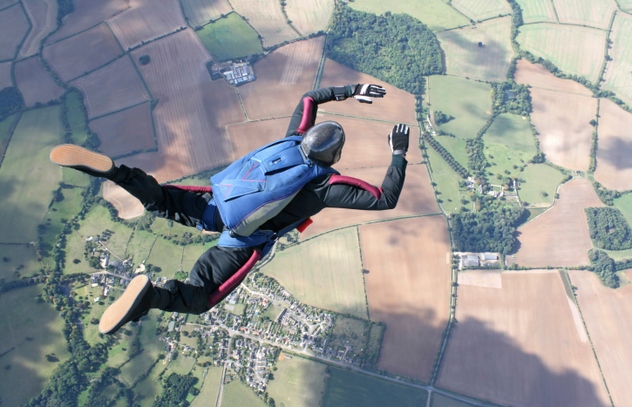
You’d think gravity would have an equal effect everywhere in the world, but it doesn’t. For example, the Hudson Bay area of Canada has a weaker gravitational pull than most places on Earth. The change is so miniscule, you’d never feel it, but modern technology can detect it. We only have theories as to the cause.
The most common theory points us to the Ice Age. When the land-depressing Laurentide Ice Sheet melted, it left an imprint that hasn’t sprung back, affecting gravity to a slight degree. This ice sheet covered most of Canada and part of North America and would have been heavier in certain areas than in others. The same thing has happened at the South Pole. Ice melting in recent years has caused a definite shift in local gravitational pull. Distribution and density of land, ocean activity, and natural processes can make a difference in the rate of gravity. An earthquake in Japan led to a quickly detected change in 2011—not that anyone could feel it.
3Pangea Ultima Is Coming
Pangea—a supercontinent with all seven modern continents formed as one landmass—existed 250 million years ago. Another 250 million years in the future, Pangea Ultima will take shape, and it will look much different than the Pangea of the past. It’s impossible to know exactly what direction the tectonic plates will move, but we can predict what will happen by observing what is happening now.
Based on this information, scientists predict California will collide with Alaska. Most of the Mediterranean is actually part of the African tectonic plate, which has been inching northward for millions of years. Africa will ram into Europe and create a gargantuan mountain range. Look to the Alps for scale and to understand the potential effects of colliding tectonic plates. Geologists estimate that the forming of supercontinents on Earth occurs cyclically, every 500–700 million years, and we’re in the middle of that cycle right now. Tectonic plates move at a rate slightly slower than average fingernail growth.
2The North Pole And The South Pole Trade Places

The magnetic “flip” of the North and South Poles is a natural cycle. It’s happened countless times in the past, and it will happen again in the future. The Earth-altering event could very well begin during our lifetime. Volcanic rock reveals that the last flip occurred 780,000 years ago. That means we’re due for the next flip in the cycle. In addition to the timing being right, magnetic activity around our planet indicates it might happen soon.
A magnetic field around the Earth protects us from extreme radiation. It’s been changing more rapidly than predicted, weakening in some areas and strengthening in others. The field is affected by the movement of Earth’s outer core. Less movement causes a decrease in the strength of the corresponding area of the magnetic field, while more movement causes an increase in strength for the corresponding area. Recent unusual activity may mean the “flip” process is being set into motion.
1Earth Is Itty Bitty
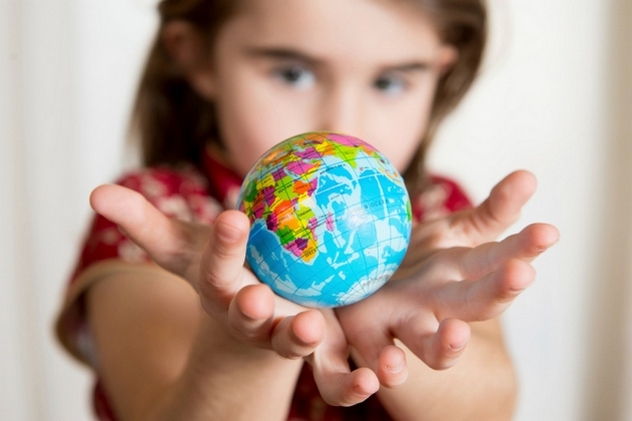
It’s no secret that the Earth is smaller than the Sun, but the contrast is outrageous. An impressive 109 Earths could fit along the face of the Sun. However, while that may be a big number, it’s nothing compared to the approximately 1.3 million Earths that could fit inside our Sun as a whole. (This is considering volume only and not taking shape into account, as adding smaller spheres to a larger sphere leaves a great deal of empty space.) Even when maintaining the spherical shape, you could still fit around 960,000 Earths in the Sun.
On top of its tremendous size, the Sun contains 333,000 times the mass of Earth and comprises 99.8 percent of the mass in our solar system. It’s still not anywhere near the largest star out there. The red supergiant Betelgeuse is roughly 500 times larger than the Sun. Now compare this to the size of Earth and, suddenly, we seem unbelievably small. Our planet really is just a speck in the universe.
Shannon M. Harris is a writer from the Seattle area. She enjoys watching stand-up comedy, visiting quirky roadside attractions, and exploring nature—as long as nature isn’t trying to kill her. Connect with (and hire) her at www.writerbug.org.








